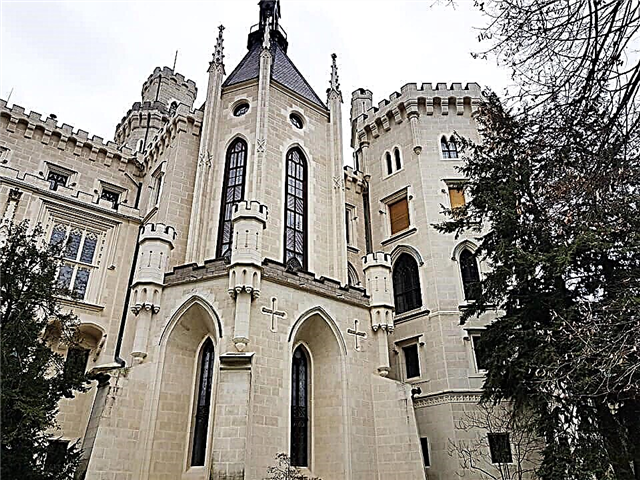Among the picturesque nature of the South Bohemian region, on a high hill, there is a small settlement of Hluboka nad Vltavou, which emerged as a medieval defensive fortress. The main attraction of the city is the snow-white neo-Gothic castle. This is one of the most famous, beautiful and most visited Czech palaces. For history buffs and incorrigible romantics, a visit to the castle will leave an unforgettable impression in their memory.
Construction history

The predecessor of the fairytale castle Hluboka nad Vltavou was a Gothic fortress, erected in the 13th century on the initiative of King Otakar II of the Czech Republic. The building was of strategic military importance. It was intended to perform guard and defensive tasks of the southern borders of the medieval state. In the period from the XIII to the XVII century, the castle was replaced by a considerable number of owners, who for various reasons parted with their possession. The fortress was sold, presented for military successes, and confiscated for debts. Each new owner made changes to the appearance of the building. The building was rebuilt and changed its architectural style: first Gothic, then Renaissance, then Baroque.

In 1661, the Gluboko estate was bought by a nobleman from Bavaria, Jan Schwarzenberg. The founder of a wealthy family, who took Austrian citizenship, was a major landowner in Bohemia. The middle of the 19th century was marked by the final reconstruction of the castle in the romantic neo-Gothic style. The Schwarzenbergs continued to own the building until the end of World War II. Since 1947, Hluboka nad Vltavou has been a nationalized landmark open to the public.
Description of the castle

The palace complex in the form of a pentagon stretches for a hundred meters along the cape, located above the Vltava River. The three-story snow-white facade of the castle is decorated with openwork balconies with stucco molding, bay windows, stone lace, thin gilded columns, an arched gallery, pointed windows and buttresses. The building, crowned with 11 crenellated towers of various heights, consists of 140 rooms, two courtyards, a glass-fronted conservatory and a stable. Hunting trophies - deer heads with antlers - are hung on the walls of the courtyard. Many windows are specially closed with opaque shutters in order to protect the exhibits in the castle halls from exposure to sunlight.
What can be seen

The delightful architecture of the Hluboko nad Vltavou palace is complemented by luxurious interior decoration. The walls, ceilings, doors and windows of the castle's majestic halls are paneled with wood and ornate lace carvings. Rooms with elegant antique furnishings are illuminated by Venetian glass chandeliers. In the vast apartments of the palace, decorated with pilasters and arches, you can see collections of unique tapestries, fine wooden, porcelain and silver figurines, as well as dishes, knightly armor, weapons, hunting trophies, painted Chinese vases and paintings by European masters of the 16th-18th centuries. In order to save heating, in winter most of the palace's premises are closed to the public.

The largest hall of the castle is the library. More than 12,000 copies of books from different eras are collected on the shelves of tall cabinets. Geographic globes, a baroque fireplace, and a large 16th century wooden table are installed around the room. The sleeping quarters of the castle are especially impressive. The carved ceiling is filled with floral motifs. The walls are framed with leather wallpaper. The room has a large wooden canopy bed on dark spiral columns.
Opening hours and ticket prices
The Hluboko nad Vltavou palace complex is open daily from 9:00 to 17:00 (in the summer season) and from 10:00 to 16:00 (in the winter season). The cost of the entrance ticket to the castle is 40-250 CZK, depending on the number of apartments visited.
Where is it located and how to get there
Located 140 kilometers from Prague. You can get to the fortress by rail. From the main station of the capital of the Czech Republic, a train runs to the city of Ceske Budejovice, from where a bus leaves every 20 minutes to the town of Hluboko nad Vltavou. There is also a direct flight from Prague's Florenc bus station. You should familiarize yourself with the timetable for intercity transport in advance.
Attractions of Cesky Krumlov
In the bend of the Vltava River, there is one of the most picturesque cities in Europe, a UNESCO World Heritage Site. This is Cesky Krumlov - the pearl of southern Bohemia. The city, founded in the XIII century, gives the impression of a fabulous Middle Ages. On the narrow streets paved with cobblestones, multi-colored buildings of bizarre shape are compactly located.
Church of St. Vitus in Cesky Krumlov

One of the significant symbols of Cesky Krumlov is the Gothic Roman Catholic Church of St. Vitus, founded in the 14th century by Prince Peter von Rosenberg. Over the years of its existence, the church has been repeatedly reconstructed and expanded, and acquired its modern look in the middle of the 19th century. The majestic basilica is an elongated rectangular building with three naves of the same height. Two-storey chapels are attached to both sides of the church. The facade of the temple, with narrow windows decorated with ornate lattices, is crowned with a high gable roof and an octagonal tower with a spire.
The interior of the basilica can be appreciated while standing in one place. The basilica hall is decorated with frescoes and statues of saints. The room has benches for parishioners. The vaulted cruciform ceiling of the main hall of the church is supported by tall, slender columns. The main Baroque altar, created in 1683, is represented by picturesque panels, located one above the other, and carved wood elements. Framed by arched gilded frames and columns, the paintings depict the coronation of Our Lady and St. Vitus. Artistic compositions are complemented by sculptures of Czech patrons. The chapels contain the tombs of two noble families of South Bohemia (Rosenberg and Schwarzenberg), as well as an ancient 15th century organ, faced with marble.
Concorde Square

All streets of Cesky Krumlov lead to the central square of Concorde. Its appearance is formed by amazing houses built on medieval foundations, the colorful facades and pediments of which reflect different architectural styles. Covered arched galleries, which have long served as trade shops of artisans, are attached to the first floors of buildings decorated with decorated plaster. The main building of the square is the Town Hall, erected in the 17th century after the merger of two Gothic buildings. On the wide facade of the local administration, you can see the coats of arms of the nobles who owned the city. The roof of the town hall is crowned with decorative vases. A small bell is suspended under the cornice, the ringing of which gathered members of the magistrate for a meeting.

In the center of the square rises the Plague Column, crowned with a statue of the Most Holy Theotokos. The building was erected in memory of the victims of the terrible disease that gripped Bohemia in 1680. The monument also expresses gratitude to the heavenly forces for saving the city from the epidemic. The column is framed by a six-sided stone fountain, decorated with eight sculptures of the patron saints of Bohemia.
Latran

Latran is the name of the historic, timeless quarter of Cesky Krumlov. The unique street, formed in the XIV-XVI centuries, begins near the wooden Lazebnicki bridge and ends at the Budejovice gate. The original appearance of the quarter has been preserved to this day.In the Middle Ages, the area was inhabited by artisans and merchants who served the princely fortress. On Latran street there are picturesque old houses, the walls of which are decorated with frescoes, decorative ornaments and various paintings imitating masonry, windows and cornices. The whimsical facades of the buildings, crowned with ornate pediments, seem to be the scenery for a fabulous movie. On the ground floors of the houses there are restaurants, shops, breweries, museums and hotels.
Minorite monastery in Cesky Krumlov

The monastery of the Minorite Order was founded by the princely family of Rosenbargs in 1350. The order demanded from its supporters the fulfillment of strict vows, including self-torture and self-restraint. The monastery consists of a complex of buildings that form courtyards. On the territory there is a baroque church of Corpus Christi and the Mother of God, small chapels, houses and educational buildings for nuns, a tower with a bell tower. The interior of the local temple is a true masterpiece of religious art. The altars are decorated with sculptures of saints, gilded bas-reliefs and magnificent wood carvings.
Cesky Krumlov castle

The main attraction of Cesky Krumlov is the majestic castle, the first stone of which was laid in 1250. Over the next centuries, the building was overgrown with new buildings, and acquired its final appearance in the middle of the 19th century. The monumental fortress is erected on a winding cliff that hangs over the city. The stone façade of the building, which rises directly from the cliff, is decorated with balconies, bay windows and windows of various shapes.
The castle consists of a complex of forty palace structures that form five courtyards. The architectural ensemble stretches for one kilometer. All the numerous rooms are connected by covered passages. The adjoining territory of the castle can be accessed through an arched bridge. In the courtyards you can see stone fountains, sculptural statues, various ancient buildings, chapels, an equestrian arena, a unique pavilion with a rotating auditorium, a picturesque park alley, and a baroque castle theater.
The interiors of the castle are filled with an ancient atmosphere. Visitors to the fortress are given the opportunity to explore the princely apartments: offices, bedrooms, wardrobes, living rooms and dining rooms. The decoration of the premises dates back to the Renaissance, Baroque and Classicism eras. Luxurious halls, decorated with tapestries, picturesque frescoes, stucco with gold painting, will bring true aesthetic pleasure.
Excursion: Cesky Krumlov and Hluboka nad Vltavou castle
Picturesque South Bohemia is famous for its rich history, traditions and ancient sights. Small fairytale towns with castles will leave unforgettable individual impressions in your memory. It is recommended to purchase a single tour to see Cesky Krumlov and Hluboka nad Vltavou Castle in one day. The tour costs 32 euros. The tour runs daily from 8:00 am, except Mondays. Departure is from Wenceslas Square.











